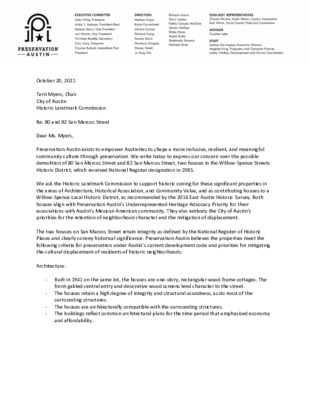C.3.a - 80-82 San Marcos St - citizen comment — original pdf
Backup

October 20, 2021 Terri Myers, Chair City of Austin Historic Landmark Commission Re: 80 and 82 San Marcos Street Dear Ms. Myers, Preservation Austin exists to empower Austinites to shape a more inclusive, resilient, and meaningful community culture through preservation. We write today to express our concern over the possible demolition of 80 San Marcos Street and 82 San Marcos Street, two houses in the Willow-Spence Streets Historic District, which received National Register designation in 1985. We ask the Historic Landmark Commission to support historic zoning for these significant properties in the areas of Architecture, Historical Association, and Community Value, and as contributing houses to a Willow-Spence Local Historic District, as recommended by the 2016 East Austin Historic Survey. Both houses align with Preservation Austin’s Underrepresented Heritage Advocacy Priority for their associations with Austin’s Mexican American community. They also embody the City of Austin’s priorities for the retention of neighborhood character and the mitigation of displacement. The two houses on San Marcos Street retain integrity as defined by the National Register of Historic Places and clearly convey historical significance. Preservation Austin believes the properties meet the following criteria for preservation under Austin’s current development code and priorities for mitigating the cultural displacement of residents of historic neighborhoods: Architecture: - Built in 1941 on the same lot, the houses are one-story, rectangular wood frame cottages. The - - - front-gabled central entry and decorative wood screens lend character to the street. The houses retain a high degree of integrity and structural soundness, as do most of the surrounding structures. The houses are architecturally compatible with the surrounding structures. The buildings reflect common architectural plans for the time period that emphasized economy and affordability. Historical Associations: Community Value: - - - - - - The Willow-Spence Streets Historic District and surrounding neighborhood reflect the history of the displacement of Mexican American residents from downtown toward East Austin in the early twentieth century, exacerbated in the 1950s with the construction of I-35. The properties reflect a history of providing affordable housing for Austin’s working class, whether carpenters, sales clerks, grocers, or auto mechanics. The neighborhood has strong ties to Austin’s Mexican American community, making it a high priority under the City of Austin’s goals of mitigating the displacement of communities of color and maintaining its still extant neighborhood character in the face of gentrification. The integration of residential structures, such as these two houses, with business, schools, and churches, is a defining feature of many neighborhoods in East Austin. The Willow-Spence Streets Historic District is included in the East Cesar Chavez Neighborhood Plan, which was adopted as part of the City of Austin’s 2012 Imagine Austin Comprehensive Plan. The East Cesar Chavez neighborhood reflects the cultural and social influences of the Mexican American, African American, and European American residents who have made this area home since the late nineteenth century. The demolition of these two houses would be the first since the neighborhood’s designation as a National Register district, opening the door to further demolitions of our valuable historic resources. East Austin has seen too many demolitions, at a rapidly increased rate, over the past several years. Every loss brings us closer to losing any chance for a historic district to honor and protect these buildings. We urge the Historic Landmark Commission to recommend designation of these homes for individual landmark designation. We further support designation of the Willow-Spence Streets Historic District as a local district to prevent additional demolitions from chipping away at this important part of East Austin’s history. Thank you for your service to our community. Allen Wise, President